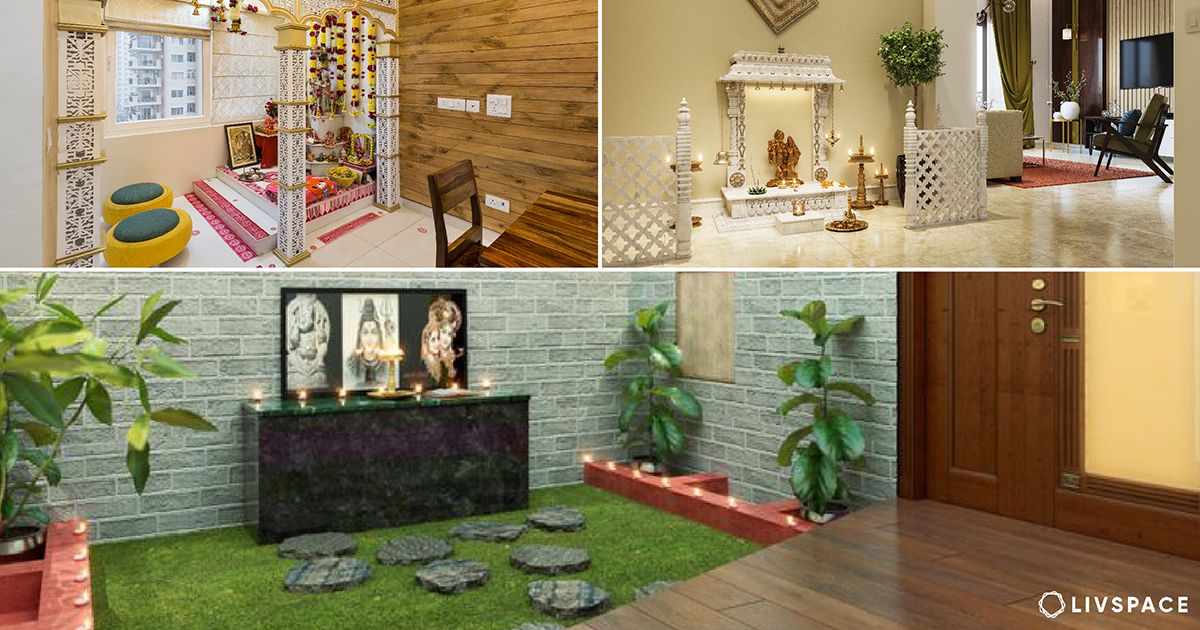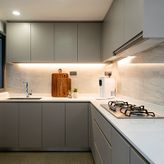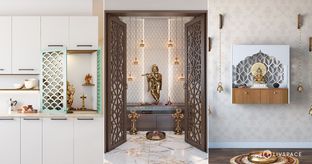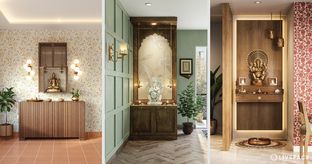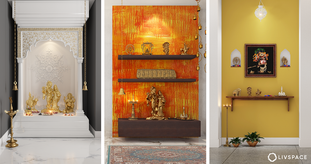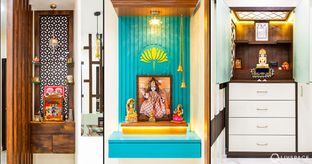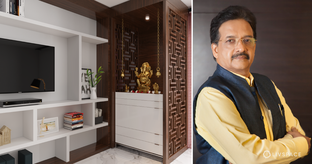In This Article
- 1. Location matters
- 2. The best direction for mandir and idols
- 3. Ideal pooja room size and proportions as per Vastu
- 4. Soft shades are ideal for your pooja room as per Vastu Shastra
- 5. Keep your pooja room on the ground floor
- 6. Candles and lamps can help ward off negative energies
- 7. Add doors to your pooja room
- 8. The living room is a good location for your mandir
- 9. Face the east while you pray
- 10. Use lamps, natural light and LEDs to brighten up your pooja room
- 11. Metallic accessories are ideal for pooja rooms
- 12. Place storage units below the idol
- 13. Keep it clean and clutter-free
- 14. Use marble or wooden flooring
- Things to avoid as per pooja room Vastu
- How can Livspace help you?
No matter how aesthetically pleasing your pooja room may appear, you might still feel like something is missing if it’s not Vastu-compliant. Additionally, no one wants to worry about potential Vastu doshas and their consequences, so adhering to pooja room Vastu principles is essential.
So, how can you ensure your mandir direction is as per Vastu without a complete redesign? Which direction should God be facing in your home? Here’s where we come in to assure you that aligning your pooja room direction with Vastu principles can be achieved through simple steps that require minimal time and effort!
Take a look at the best Vastu tips for a puja room below:
1. Location matters
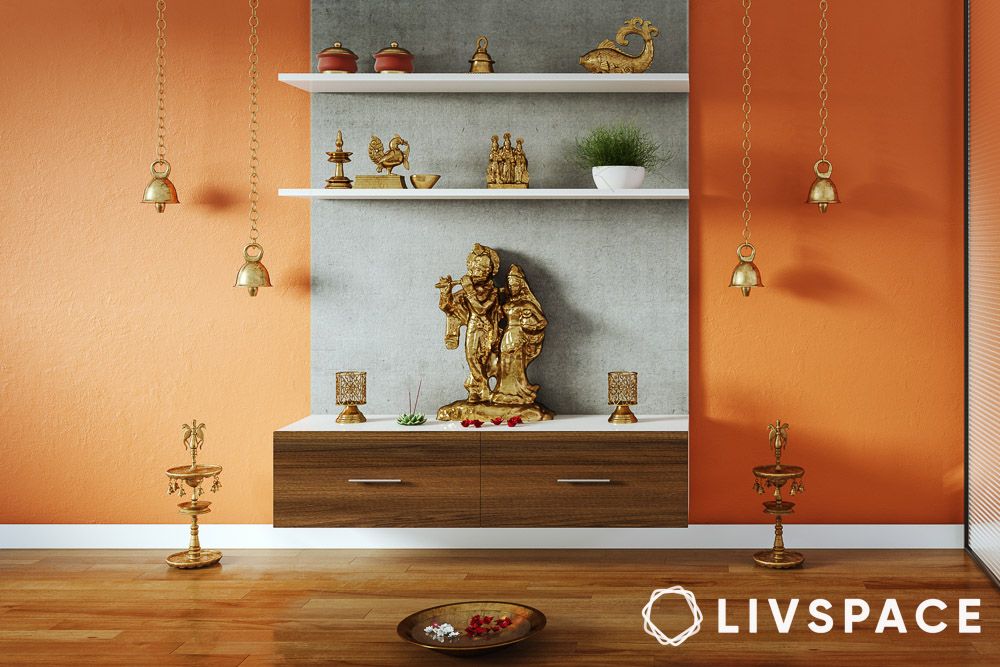
First things first, where should you place the idol in your pooja room? The placement of the idol is a crucial aspect in the books of Vastu Shastra. The pooja room Vastu emphasises that the northeast location, known as Ishan kona, maximises positive energy flow. The direction for a temple in the home should align with this principle for optimal benefits.
How to fix dosha if the pooja room is in the wrong location?

If your pooja room Vastu isn’t in the ideal northeast corner, don’t worry. The direction for the temple in a home can be adjusted using these remedies:
- Install a mirror on the northeast wall to reflect positive energy
- Place a crystal pyramid in the northeast corner
- Use yellow or white curtains to enhance spiritual energy
The mandir direction in the house can significantly impact your home’s energy, so these fixes are essential for maintaining harmony.
2. The best direction for mandir and idols
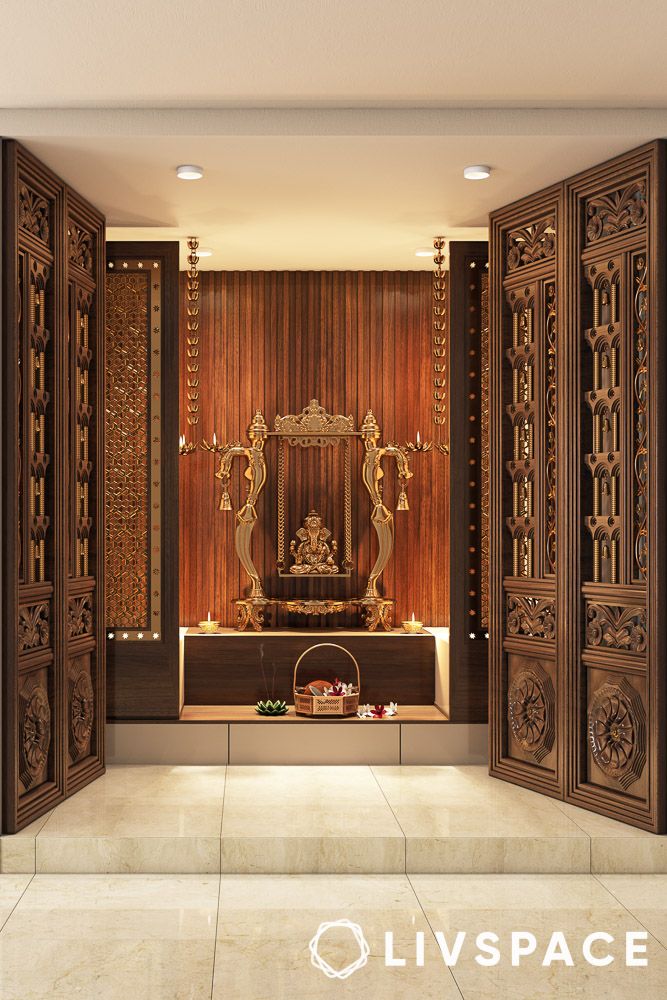
Before considering decorative elements, ensure your mandir direction in the house aligns with fundamental principles. The direction for mandir at home should prioritize the morning sun’s energy. As per Vastu, pooja room principles, this placement enhances the spiritual atmosphere during morning prayers. It also suggests maintaining a balance between the direction and the room’s other elements. Follow the below directions for the best results.
2A: Best direction for mandir:
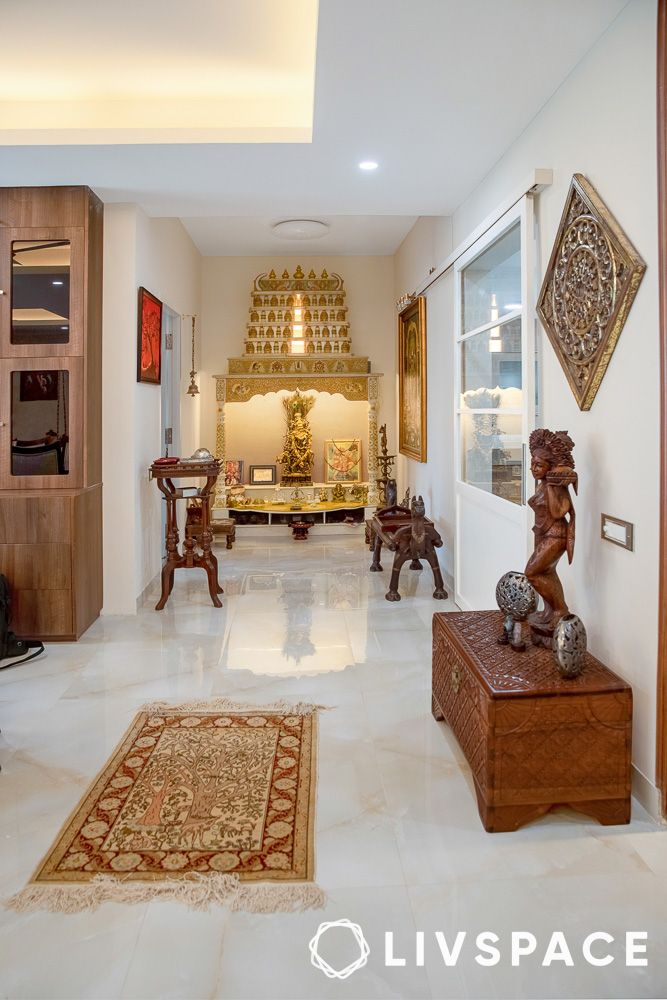
The best direction for mandir placement is facing east or west. As per pooja room Vastu guidelines, the mandir facing direction in a home should allow the devotee to face east while praying. The direction of the mandir in a home as per Vastu also recommends keeping a small space between the idol and the wall for energy flow.
2B: Best direction for idol:

The direction for the pooja room as per Vastu suggests that idols should face east or west. The temple position as per Vastu emphasises that multiple idols shouldn’t face each other, as this can create conflicting energy fields. The direction of the mandir in house should align with these principles for optimal spiritual benefits.
How to fix dosha if the pooja room is in the wrong direction?

If your mandir position as per Vastu isn’t ideal, consider these solutions:
- Install a Vastu pyramid in the northeast corner
- Use copper strips on the eastern wall
- Place a brass Vastu plate beneath the mandir
These remedies can help correct the pooja room direction as per Vastu.
If the mandir is in the South:
When the direction of the mandir in a home as per Vastu isn’t perfect and faces south, you can:
- Install a mirror on the opposite wall
- Place a yellow carpet or mat in front
- Use brass or copper accessories
The direction for the temple in a home can be energetically corrected using these methods.
If the mandir is in the Southwest:
For southwest-facing temples, pooja room according to Vastu suggests:
- Adding a crystal pyramid
- Using white or yellow curtains
- Installing brass bells
These solutions help balance the pooja room facing Vastu even in less ideal locations.
If the mandir is in the Southeast:
When the direction for the pooja room as per Vastu isn’t northeast, and the temple is in the southeast:
- Place a copper yantra
- Use silver accessories
- Install appropriate lighting
These remedies help maintain proper pooja room position as per Vastu.
3. Ideal pooja room size and proportions as per Vastu

As per pooja room Vastu size guidelines, the ideal dimensions are:
- Minimum 5×7 feet for a dedicated room
- At least 3×3 feet for a wall-mounted unit
- Height should be 5-7 feet
The pooja room, according to Vastu, should not exceed 9×9 feet as larger spaces can disperse spiritual energy. As per pooja room Vastu size recommendations, ensure the ceiling height is proportional to the room’s width.
The pooja room as per Vastu Shastra emphasises not just height but also proportions. The direction for mandir at home should work in harmony with your room’s dimensions. As per Vastu, pooja room size considerations, the height of your mandir should be proportional to the room’s width.
4. Soft shades are ideal for your pooja room as per Vastu Shastra
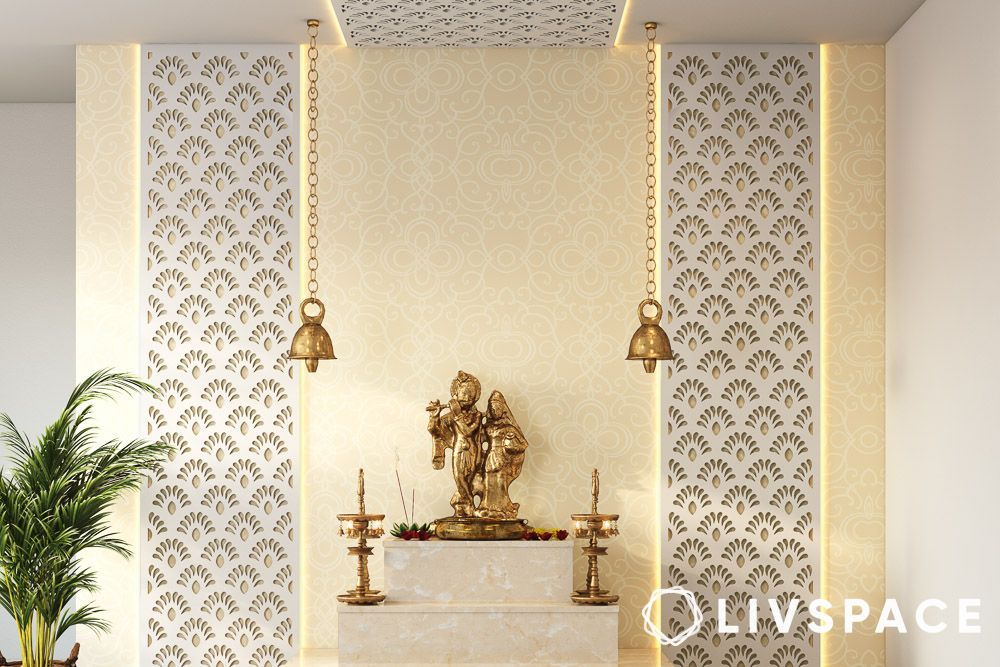
Now that we have the directions locked down, let’s focus on the aesthetics of the pooja room. Colours play an important role in making your mandir Vastu-compliant, so you want to be certain you’re picking the right shades. While choosing colors, remember that the pooja room direction as per Vastu influences how light reflects in the space. The direction of the mandir in house should complement your colour choices for maximum benefit.
For a Vastu-compliant pooja room, you can choose shades like white, cool blues or soft shades of yellow and orange. Using delicate and soothing colours in your mandir can augment the sanctity of the space.
Also Read: Top 5 Colours That Will Bring Good Vastu Vibes to Your Pooja Room
5. Keep your pooja room on the ground floor
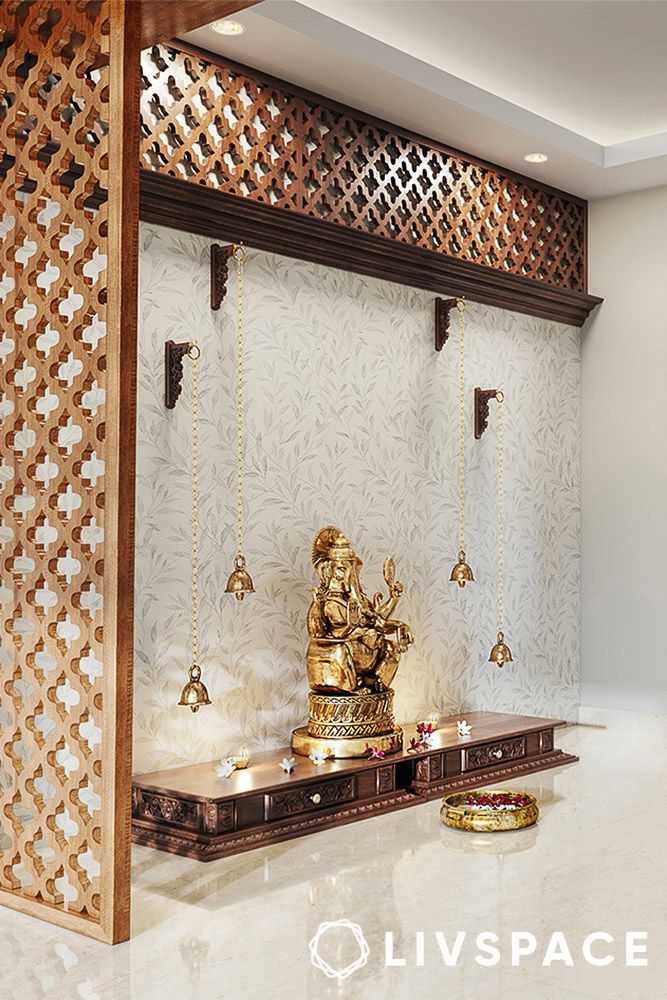
As per pooja room Vastu Shastra, the ground floor of your home or apartment is ideal for placing your mandir unit. However, it is important to position your mandir away from bathrooms and staircases to maintain the sanctity of the space.
If space constraints make this challenging, there’s no need to worry. Livspace designers are here to help you set up a mandir that aligns with Vastu guidelines.
To enhance the spiritual ambience, place your idols on a raised platform. You can choose an elaborately carved wooden platform or even a simple bench to elevate your idols, ensuring they are above ground level.
Also Read: 25+ Beautiful Small Pooja Room Designs for Your Home
6. Candles and lamps can help ward off negative energies
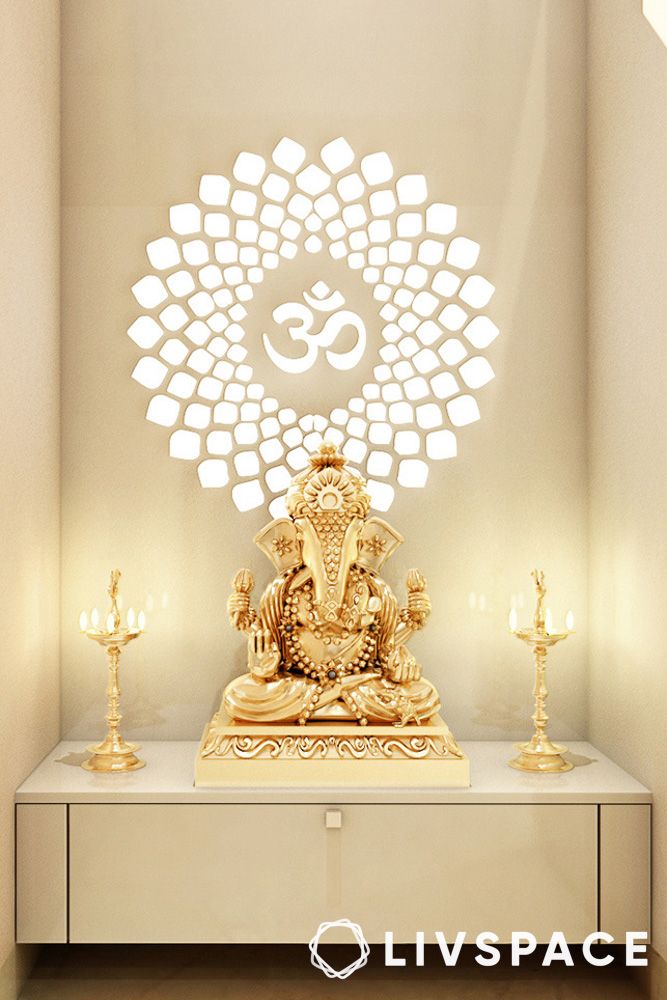
According to Vastu tips for the mandir in a house, lighting lamps and candles in the mandir is a cherished tradition that adds warmth and serenity to the space. According to pooja room Vastu Shastra, this practice helps to ward off negative energies, creating a positive and peaceful atmosphere.
For the best results, place your lamps in front of the idols, preferably in the south-east direction. This specific placement enhances the flow of positive energy throughout the room. If you’re a stickler for uniformity, consider choosing lamps that complement your decor.
7. Add doors to your pooja room
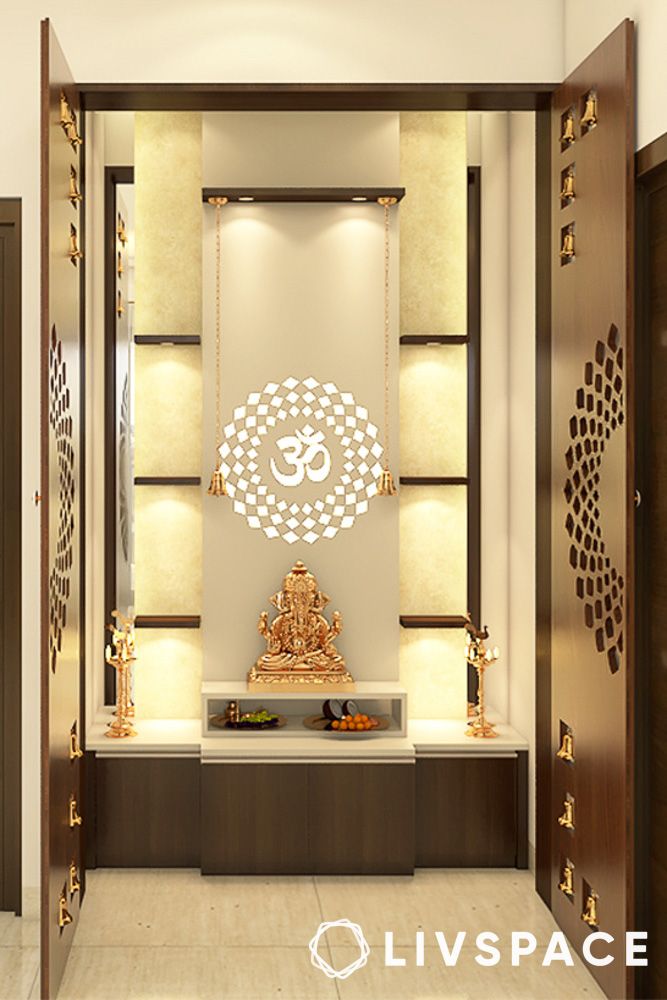
The design of your pooja room will determine whether you can add doors to it. If you have a standalone pooja room, consider adding interesting pooja room door designs to ensure privacy during prayers and to create a more secluded, tranquil space.
Additionally, doors and a threshold help prevent insects from entering this sacred area, maintaining its purity. For optimal alignment, position the door against the north or east wall, according to Vastu tips for your mandir. This placement not only upholds tradition but also enhances the positive energy flow for the puja room as per Vastu in the house.
8. The living room is a good location for your mandir
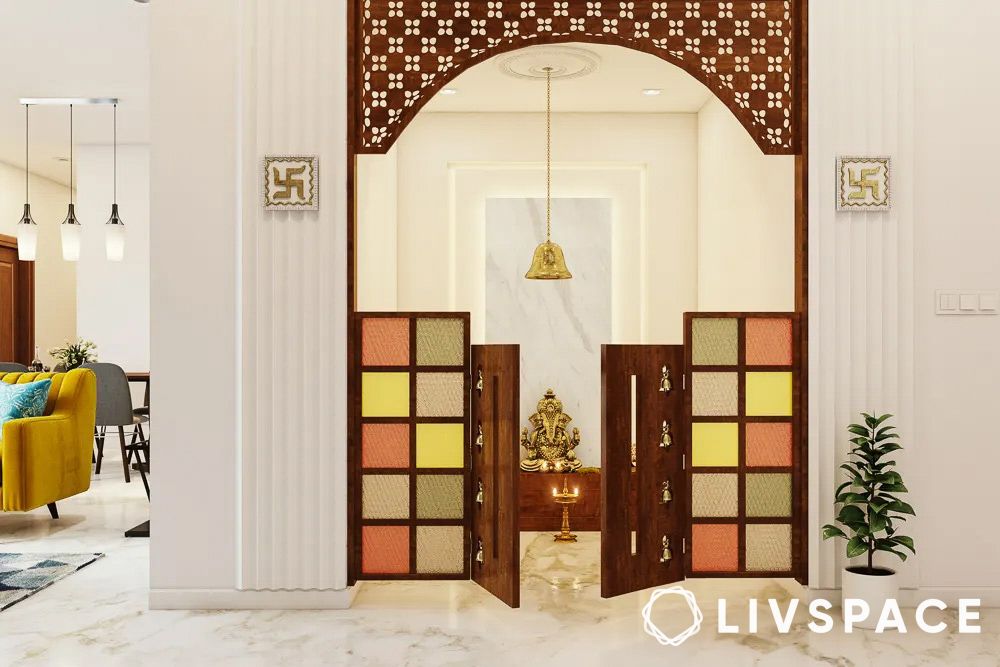
The pooja room as per Vastu Shastra emphasises the importance of proper placement within the living space. The best direction for the mandir when placed in the living room should align with the northeast energy fields.
Ideally, your pooja room should be in a well-lit and well-ventilated area to maximise positive energy flow and create a serene atmosphere for your prayers and rituals.
9. Face the east while you pray

We know that your idols should face the northeast direction in your pooja room, but which direction should you face while praying? The pooja room Vastu guidelines emphasize that your prayer direction is as important as the direction for the mandir at home. The temple position as per Vastu should allow family members to face east during prayers. If facing east isn’t possible, praying facing west is also acceptable. However, avoid facing south, as it is generally considered inauspicious.
10. Use lamps, natural light and LEDs to brighten up your pooja room
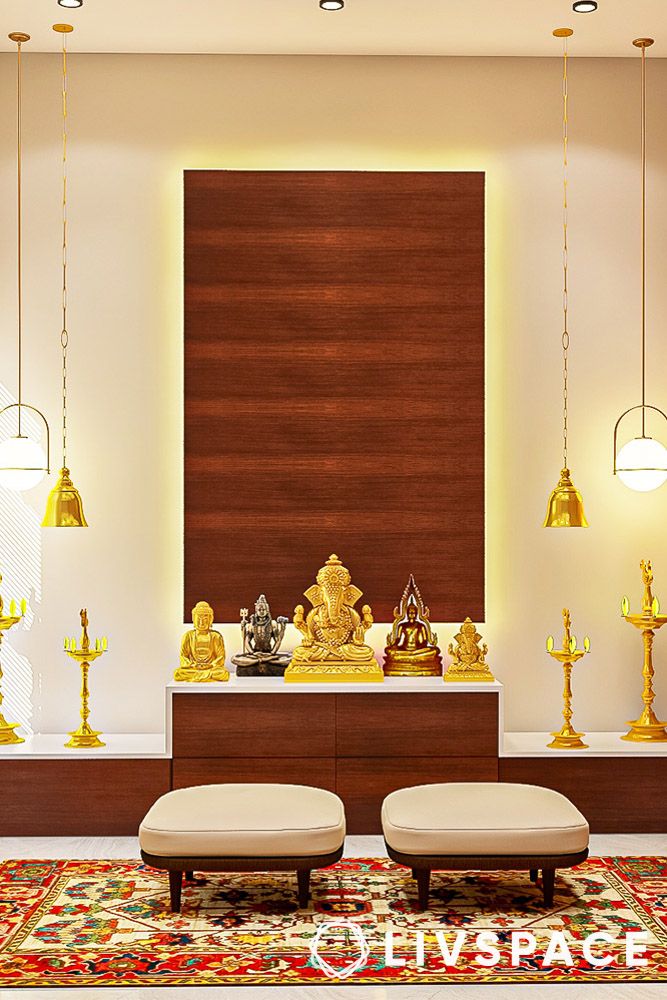
The direction of a temple in the home affects how natural light enters the space. The pooja room Vastu guidelines suggest maximising morning sunlight exposure for enhanced spiritual energy. It also brightens your home and helps keep it free from the bacteria and germs that thrive in dark, damp places. If possible, place your pooja room unit near a window to ensure it stays well-lit during the day.
In addition to natural light, you can use lamps and LED lights to illuminate the space after sunset.
Also Read: 4 Pooja Room Lights That Are Gloriously Divine
11. Metallic accessories are ideal for pooja rooms
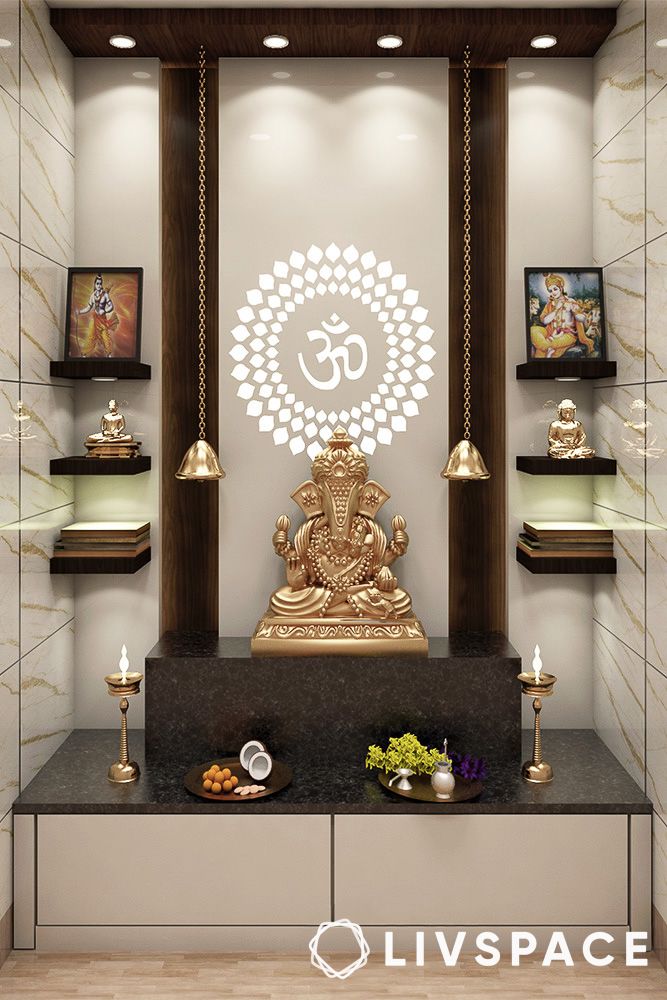
According to pooja room Vastu Shastra, the sonorous sounds produced by metals are known to dispel negative energy. Therefore, when selecting accessories for your pooja room, opt for items made of metal. Additionally, incorporating a small water body, such as a bowl with flowers and diyas, can enhance positive energy and bring good luck.
Other accessories to consider for decorating your pooja room include incense stick holders, bells, framed images of idols, hanging lamps, and flower garlands. These elements not only adhere to Vastu principles but also enhance the overall ambience of your sacred space.
The direction of the mandir in the house affects how metal accessories should be arranged. As per Vastu, pooja room size and layout, ensure metal items don’t obstruct the main deity’s view.
12. Place storage units below the idol

Storage is a crucial aspect of maintaining a clean and clutter-free pooja room. Ensure that there are ample storage units below the idol to keep all your pooja essentials like incense sticks, matchboxes, prayer books, and other items. This not only keeps the pooja room tidy but also ensures that everything you need is within easy reach.
13. Keep it clean and clutter-free

Keeping your pooja room clean and clutter-free is essential in maintaining a sanctified space, as per Vastu. Regularly dust and clean the room, and ensure that items are neatly organised. Clutter can disrupt the flow of positive energy, so keep only the necessary items in the pooja room and store others away.
14. Use marble or wooden flooring

The pooja room Vastu suggests using specific flooring materials:
- White marble creates a pure, serene atmosphere
- Wooden flooring brings warmth and natural energy
- Avoid dark-coloured or black flooring
As per pooja room Vastu size and flooring guidelines, ensure the material extends at least 2 feet beyond the mandir area.
Also Read: Marble Flooring Designs That Can Make Your Home Vibrant and Classy
Things to avoid as per pooja room Vastu
When planning your home temple, the pooja room Vastu reminds us to avoid certain arrangements. The direction for mandir at home shouldn’t create negative energy pockets. The direction for a temple in the home should promote free energy flow while maintaining respectful distances from unsuitable areas.
1. Do not place photographs of the deceased in your pooja room
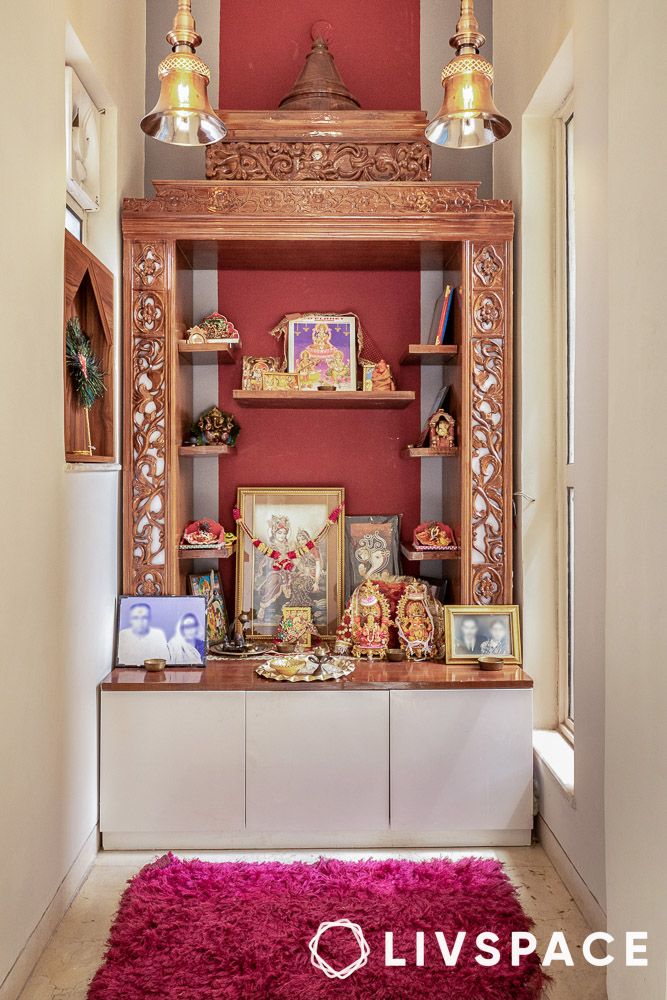
It’s a common practice in Indian homes to place pictures of deceased relatives in the direction facing the pooja room. However, did you know that this is against puja room Vastu recommendations?
While you can offer prayers to your ancestors in the pooja room, it’s advisable to avoid keeping their pictures in this space. Experts suggest placing such photographs in the south or southwest part of your home instead.
Additionally, since the pooja room is a sanctified space, Vastu guidelines emphasise keeping only soothing pictures in the pooja room to enhance its sanctity. Avoid displaying images depicting war or strife and instead opt for calming photographs of flowing water or nature to create a serene atmosphere in your pooja room.
Also Read: 15+ Pooja Room Designs That are Unique and Perfect for Indian Homes
2. Broken idols are inauspicious, so avoid keeping them at home
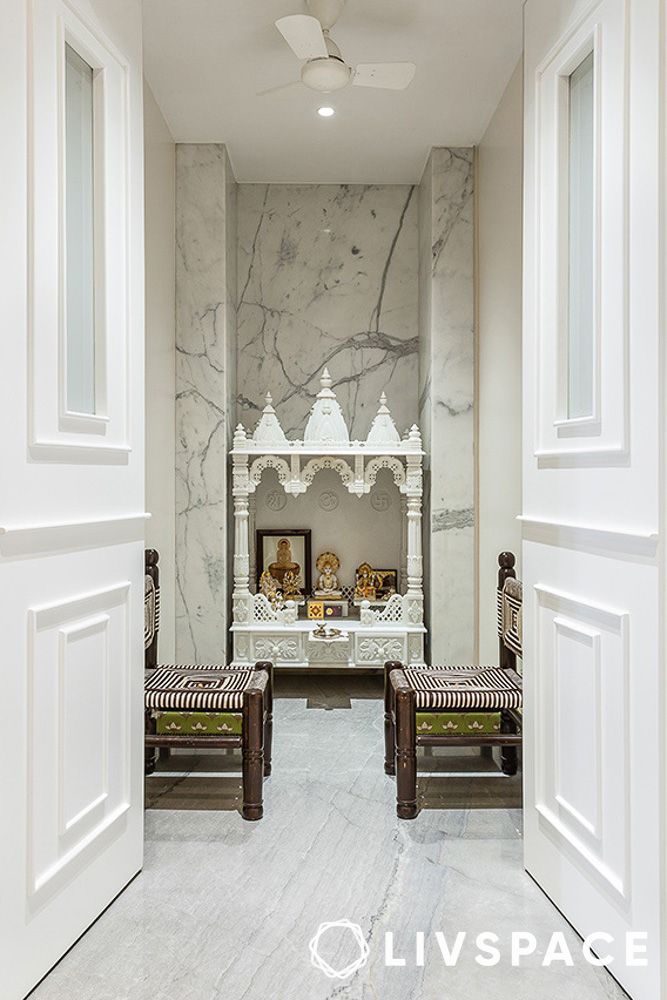
According to Vastu rules, it is considered inauspicious to keep broken or cracked idols of gods and offer prayers to them. Doing so can lead to Vastu doshas in your pooja room. However, it’s essential not to hastily dispose of damaged idols.
Experts recommend disposing of damaged idols by immersing them in holy rivers or placing them under a peepul tree. As part of regular maintenance, ensure that all idols in your pooja room are in top condition to maintain a harmonious and positive spiritual environment.
3. Avoid keeping your idols very close to the wall
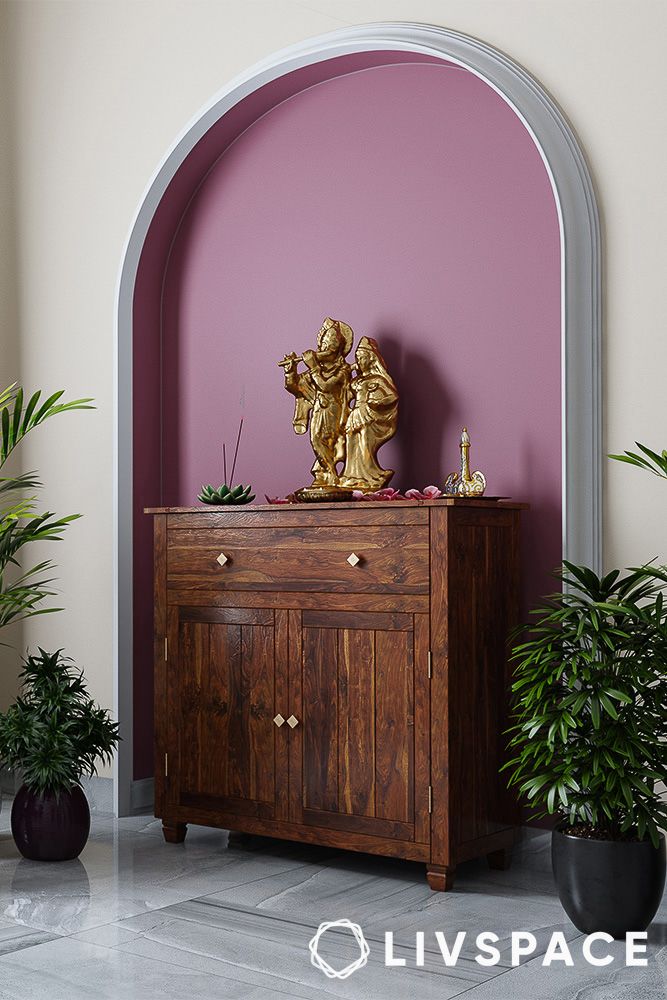
Vastu experts advise against placing your idols directly against the wall. This recommendation stems from the importance of allowing proper air circulation around your idols.
To ensure this airflow, leave about an inch and a half of space between your idols and the wall. This simple adjustment not only promotes air circulation but also allows the fragrance of incense to permeate the room, creating a delightful and fragrant atmosphere during prayers and rituals.
4. Do not overcrowd the pooja room area
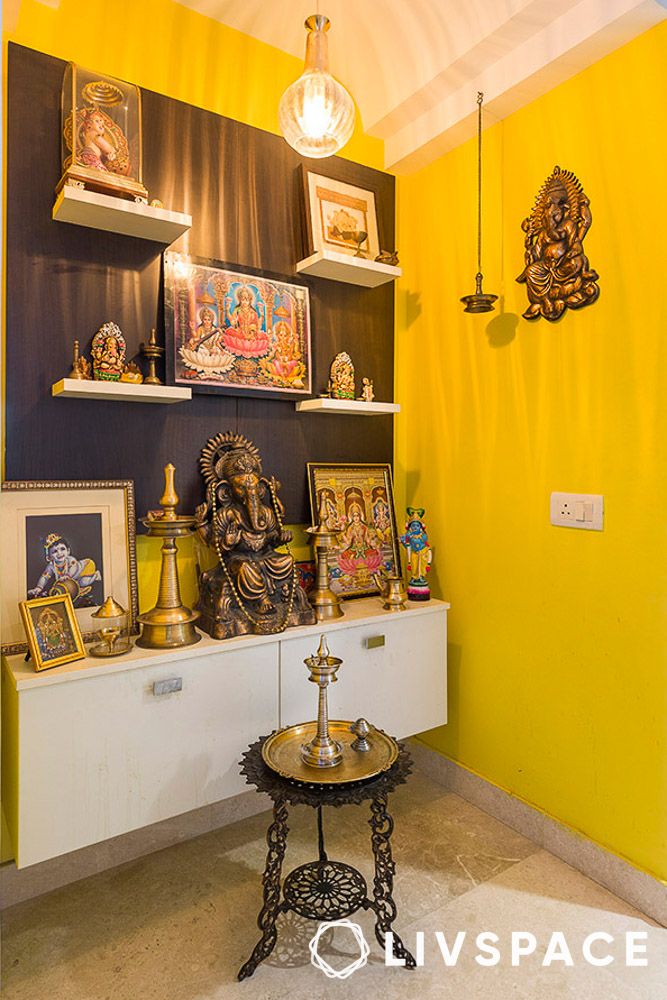
In a pooja room, maintaining a serene and uncluttered environment is essential for fostering a tranquil atmosphere conducive to prayer and meditation. Overcrowding with too many idols and religious items can disrupt the flow of positive energy and create a sense of chaos in this sacred space.
To avoid overcrowding, limit the number of idols in your pooja room. Ideally, each idol should have its own designated space, allowing for a clear focus during prayers.
The pooja room according to Vastu also suggests that space utilization is crucial. The mandir direction in a house should allow for comfortable movement during rituals. Consider the direction for the mandir at home when planning storage solutions to maintain clutter-free spaces.
5. Avoid these directions and areas
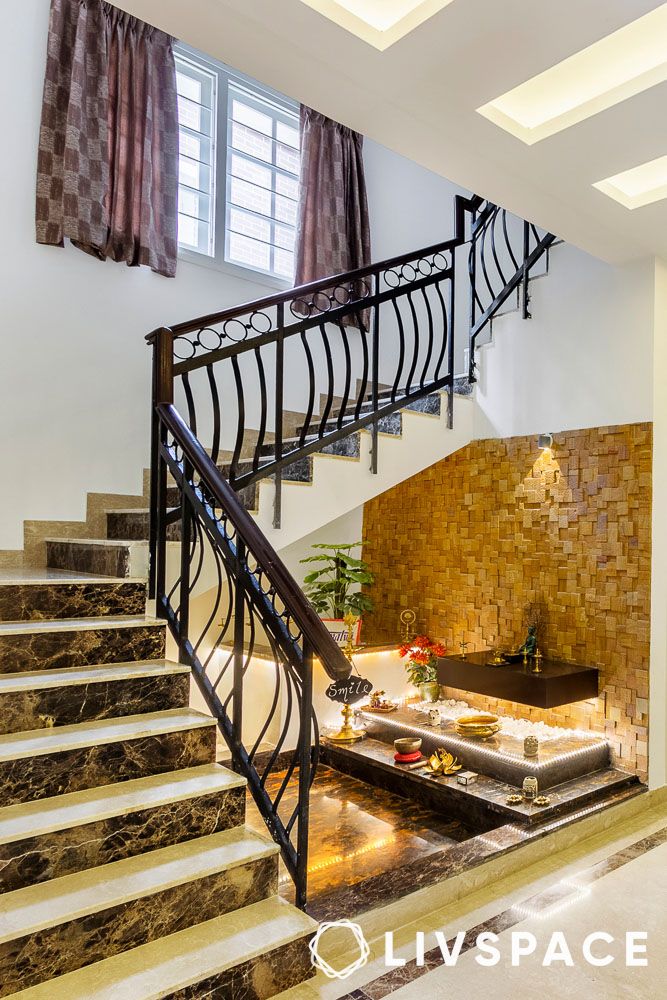
- South-southwest (SSW): The south-southwest direction is generally considered inauspicious for your pooja room. Avoid placing your pooja room here to maintain a positive energy flow
- Under the stairs: Placing a pooja room under the stairs is not recommended as per Vastu. The area under the stairs is considered to be filled with heavy, stagnant energy which is not suitable for a sacred space
- Bathroom adjacent: Your pooja room should not be adjacent to or share a wall with a bathroom. Bathrooms are associated with impurities, which can negatively affect the sanctity of your pooja room
- Basement: Placing your pooja room in the basement is not ideal according to Vastu principles. Basements are typically darker and may not receive adequate natural light, which is crucial for a pooja room
Regular maintenance is essential for maintaining pooja room Vastu energy. The pooja room Vastu reminds us that cleanliness affects spiritual vibrations. The pooja room according to Vastu principles suggests weekly deep cleaning to maintain sacred energy. The direction of the mandir in the home as per Vastu should be checked periodically to ensure alignment hasn’t shifted.
Remember that the pooja room as per Vastu Shastra guidelines is meant to enhance your spiritual experience. The mandir direction in the house plays a crucial role in maintaining positive energy flow throughout your home. Following these pooja room positions as per Vastu principles will help create a sacred space that uplifts your entire household.
Also Read: 5+ Vastu Expert Tips to Avoid Making These Pooja Room Design Mistakes
How can Livspace help you?
We trust that you’ve found these Vastu-compliant pooja room tips beneficial! If you’re seeking beautifully designed interiors that align with Vastu principles for your home, your search ends here. Book an online consultation with Livspace today.
- Our team can custom design your dream home with curated render designs and expert advice
- We have delivered over 75,000 happy homes
- Count on us for premium-grade materials that are not only high-quality but also built to last

